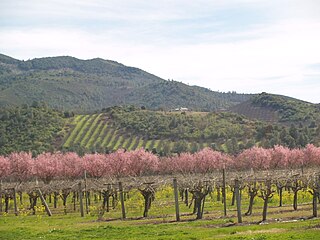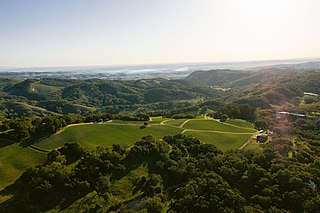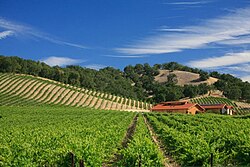
An American Viticultural Area (AVA) is a designated wine grape-growing region in the United States, providing an official appellation for the mutual benefit of wineries and consumers. Winemakers frequently want their consumers to know about the geographic pedigree of their wines, as wines from a particular area can possess distinctive characteristics. Consumers often seek out wines from specific AVAs, and certain wines of particular pedigrees can claim premium prices and loyal customers. If a wine is labeled with an AVA, at least 85% of the grapes that make up the wine must have been grown in the AVA, and the wine must be fully finished within the state where the AVA is located.

Willamette Valley is an American Viticultural Area (AVA) which lies in the Willamette Valley of Oregon. The AVA is the wine growing region which encompasses the drainage basin of the Willamette River. It stretches from the Columbia River in the north to just south of Eugene in the south, where the Willamette Valley ends; and from the Oregon Coast Range in the west to the Cascade Mountains in the east. At 5,360 square miles, it is the largest AVA in the state, and contains most of the state's wineries; approximately 908 as of 2021.

Columbia Gorge is an American Viticultural Area (AVA) which includes land surrounding the Columbia River Gorge, straddling the border between Oregon and Washington. The AVA was established by the Alcohol and Tobacco Tax and Trade Bureau {TTB), Treasury on July 9, 2004 after reviewing the petition submitted by Mark Wharry, on behalf of the Columbia River Gorge Wine Growers Association, proposing the viticultural area named "Columbia Gorge." The 280 square miles AVA is located about 60 miles (97 km) east of Portland, Oregon, straddles the Columbia River for 15 miles (24 km), and extends into south-central Washington and north-central Oregon. The area surrounds Hood River, Oregon, and White Salmon, Washington, and is generally bordered by B Z Corner, Washington, on the north; Lyle, Washington, on the east; Parkdale, Oregon, on the south; and Vinzenz Lausmann State Park, Oregon, on the west. The area is just west of the established Columbia Valley viticultural area and shares a border with it. Due to the significant gradations of climate and geography found in the gorge, this AVA exhibits a wide range of terroir in a relatively small region; it is marketed as a "world of wine in 40 miles".

Columbia Valley is an American Viticultural Area (AVA) which lies within the Columbia River Plateau, through much of central and southern Washington state, with a section crossing the state boundary into northern Oregon south of the Columbia River. The viticultural area includes the drainage basin of the Columbia River and its tributaries through much of Washington. It was established by the Bureau of Alcohol, Tobacco and Firearms (ATF), Treasury on December 13, 1984 after evaluating the petition filed by Drs, Walter Clore and Wade Wolfe of Prosser, Washington on behalf of Washington’s oldest and largest winery, Chateau Ste. Michelle, and by William Blosser of the Sokol Blosser Winery, Dundee, Oregon. Allen Shoup, president of Chateau Ste. Michelle, understood the importance of obtaining appellation status to grow the reputation of the Northwest viticulture industry.

Temecula Valley is an American Viticultural Area (AVA) in the Temecula Valley, located in southwestern Riverside County, California against the eastern slopes of the Santa Ana Mountains. It was initially established by the Bureau of Alcohol, Tobacco and Firearms (ATF), Treasury as "Temecula" on October 23, 1984 based on submitted petitions from by the Rancho Califomia/Temecula Winegrowers Association and Callaway Vineyard and Winery, Temecula, California in 1982. It was renamed "Temecula Valley" by the Alcohol and Tobacco Tax and Trade Bureau (TTB) in 2004, approving the 2001 petition by Temecula Valley Winegrowers Association. The petition stated the name change would provide a more accurate description of the Temecula geography and greater clarity as to its location for wine consumers and the public. The petition did not request any change to the established AVA boundaries. This was the first American Viticultural Area to change its name after the initial approval. Temecula Valley encompasses 33,000 acres (52 sq mi) and 5,000 acres (8 sq mi) is located in a "protected" area referred to as the Citrus/Vineyard Zone. This area is generally located in and around the Rancho California Road area with Riverside County. County guidelines strictly enforce the number of acres needed to build a winery, lodging and other limited housing and commercial ventures.
Monticello is an American Viticultural Area (AVA) located in the central Piedmont region of the Commonwealth of Virginia. It was established by the Bureau of Alcohol, Tobacco and Firearms (ATF) on February 22, 1984 after six wine grape growers in the Charlottesville area petitioned the ATF to designate a viticultural area to be known as “Monticello.” The name "Monticello" is known nationally and locally as the historic home of Thomas Jefferson, located near the center of the area. Monticello AVA includes most of Albemarle, Fluvanna, Greene, Orange, and Nelson counties. The area is nestled along the eastern slopes of the Blue Ridge Mountains and encompasses the small ridge known as the Southwest Mountains. There are approximately 30 varieties of grapes grown in the Monticello AVA. However, the most notable grapes grown in the area include Cabernet Franc, Chardonnay and Viognier. The hardiness zone is 7a except in some higher vineyards which are 6b. In 2019, the Tax and Trade Bureau (TTB) granted a petition to expand the AVA by approximately 106,240 acres (166 sq mi) into Fluvanna County.

Central Coast is a vast American Viticultural Area (AVA) that spans along the Central California Pacific coastline from the San Francisco Bay Area south through Monterey, San Luis Obispo and Santa Barbara Counties. It was established on November 25, 1985 by the Bureau of Alcohol, Tobacco and Firearms (ATF), Treasury after reviewing the petition submitted by Taylor California Cellars, a winery in Gonzales, California, to establish the "Central Coast" viticultural area. The boundaries of the Central Coast, which have been expanded twice, includes portions of six counties where approximately 100,000 acres (40,469 ha) cultivated with Chardonnay being more than half of the varietal. Within the multi-county AVA are numerous established appellations that share the same maritime climate produced by the Pacific Ocean.
Arroyo Grande Valley is an American Viticultural Area (AVA) located in San Luis Obispo County, California approximately 12 miles (19 km) southeast of the county seat San Luis Obispo. Arroyo Grande Valley was recognized on February 5, 1990 by the Bureau of Alcohol, Tobacco, Firearms and Explosives (ATF) as the state's 60th AVA based on the petition filed in 1987 by Don Talley of Talley Vineyards and William S. Greenough of Saucelito Canyon Vineyard for the establishment of the "Arroyo Grande Valley" viticultural area in San Luis Obispo County. The 16 miles (26 km) long, approximately 67 square miles valley appellation benefits from its east-northeast orientation allowing the breeze from the Pacific Ocean to moderate the climate of the area. The valley is divided by a fog line produced by the cool maritime layer where Zinfandel, Petite Sirah and Rhône varietals are grown on the higher elevations near Lopez Lake and the cooler mid-valley vineyards being home to Chardonnay and Pinot noir. On April 8, 2022, the Alcohol and Tobacco Tax and Trade Bureau (TTB) approved the designation of the expansive San Luis Obispo (SLO) Coast AVA overlapping the boundaries of Edna Valley and Arroyo Grande Valley viticultural areas because they share common features. However, these two previously established areas still have unique characteristics to retain their viticultural area distinctions within SLO Coast. Edna Valley lies immediately to the northwest, the Los Padres National Forest straddles the north leg boundary, the Santa Maria Valley AVA lies to the southeast of Arroyo Grande Valley, and the Pacific Ocean communities of Oceano, Grover City and Arroyo Grande abut its southwestern border.

Sierra Foothills is a vast American Viticultural Area (AVA) encompassing the foothill "belt" of the Sierra Nevada in north-central California, United States. It was established on December 18, 1987 by the Bureau of Alcohol, Tobacco and Firearms (ATF), Treasury after evaluating the petition filed by the Sierra Foothills Winery Association of Somerset, California for the establishment of a "Sierra Foothills" viticultural area in portions of Yuba, Nevada, Placer, El Dorado, Amador, Calaveras, Tuolumne and Mariposa Counties. Wine grapes were introduced to the area in the nineteenth century during the California Gold Rush. Over 280 vineyards/wineries are located within its boundaries.
The Chiles Valley is an American Viticultural Area (AVA) located in Napa County, California and a sub-region within Napa Valley AVA. It was established as California's 81st AVA by the Bureau of Alcohol, Tobacco and Firearms (ATF) on April 19, 1999 after the ATF received the petition from Mr. Volker Eisele, owner of the Volker Eisele Vineyard and Winery proposing a new viticultural area in Napa County to be known as "Chiles Valley District".

Fiddletown is an American Viticultural Area (AVA) in Amador County, California, United States. The area was established on November 3, 1983 by the Bureau of Alcohol, Tobacco and Firearms (ATF), Treasury after reviewing the petition submitted from the Fiddletown Wine Grape Growers in Amador County to establish a viticultural area to be known as "Fiddletown." The region was first settled in 1849, during the California Gold Rush. Settlers who stayed in the area eventually planted grape vines, which became abundant by the end of the nineteenth century. Most of the vineyards in the Fiddletown AVA are located in the south and west portion of the region on Sierra Nevada slopes between 1,500 to 2,500 feet (457–762 m) above sea level. About 20% of the wine produced in Amador County comes from Fiddletown viticultural area.

Lake County wine is an appellation that designates wine made from grapes grown mostly in Lake County, California. The region is located north of Napa County and east of Mendocino County. Although each region within Lake County has unique viticultural attributes, many are influenced by Clear Lake, the largest inland body of water in California.

Clear Lake is an American Viticultural Area (AVA) located in Lake County, California. It was established on June 7, 1984 by Bureau of Alcohol, Tobacco and Firearms (ATF), Treasury after reviewing the petition submitted by three of the grape-growers and winery owners located in an area surrounding the watershed of Clear Lake in southwestern Lake County. The petition requested the viticultural area to be named "Clear Lake."

York Mountain is an American Viticultural Area (AVA) in San Luis Obispo (SLO) County, California. It lies within the larger Central Coast AVA located on the eastern side of the Santa Lucia Mountains and west of Paso Robles viticultural area. The mountainous terrain features vineyards that are mostly cultivated at an elevation around 1,500 feet (460 m). York Mountain climate is cooler and wetter than Paso Robles being just 8 miles (13 km) from the Pacific Ocean. York Mountain viticultural area was recognized as the county’s second AVA by the Bureau of Alcohol, Tobacco and Firearms (ATF) effective on September 23, 1983 after reviewing the petition submitted by Stephen and Max Goldman, owners of York Mountain Winery, to establish a area known as “York Mountain.” Historically, Andrew York, a British immigrant, planted the first vineyard on York Mountain in the 1870s and established Ascension Winery, the first bonded winery in the Central Coast. It survived through Prohibtion and later renamed York Mountain Winery, staying in the York family until 1970 when it was purchased by Max Goldman.

Sta. Rita Hills is an American Viticultural Area located in Santa Barbara County, California. From its creation in 2001 through 2006, the wine appellation was officially named Santa Rita Hills AVA. The formal name change was the result of a protest by and subsequent negotiations with Vina Santa Rita, a very large Chilean wine producer that was concerned about the AVA name diluting its international brand value. The name change took effect on January 5, 2006, with a yearlong period for producers in the AVA to change their wine labels. In 2016, TTB expanded the approximately 33,380 acres (52 sq mi) “Sta. Rita Hills” viticultural area by approximately 2,296 acres (4 sq mi).
Adelaida District is an American Viticultural Area (AVA) located on the north west portion of the Paso Robles AVA in San Luis Obispo County, California. It was established by the Alcohol and Tobacco Tax and Trade Bureau (TTB) on November 10, 2014 after reviewing the petition submitted by The Paso Robles Viticultural Area Committee (PRVAC) to establish 11 new distinct viticultural areas located within the spacious Paso Robles AVA. The 59 wine industry members who constitute PRVAC cumulatively own or manage over 10,000 acres (4,047 ha) of cultivated vineyards within the proposed AVAs. Wineries located within the Adelaida District are: The Farm Winery, Peachy Canyon Winery, Le Cuvier, Alta Colina, Carmody McKnight Estate Wines, Wild Coyote, Villicana, McPrice Myers, Jacob Toft, Chronic Cellars, Vines on the Marycrest, Nenow Family Wines, Hawks Hill Ranch, Adelaida Cellars, DAOU, Calcareous, Law Estate, Nadeau, Minassian Young, Michael Gill, Villa Creek, Brecon, HammerSky, Oso Libre, Poallilo, Thacher Winery, Whalebone Vineyard, Tablas Creek Vineyard, Halter Ranch, Rangeland, Justin, Kukkula, Dubost, and Starr Ranch.
Creston District is an American Viticultural Area (AVA) located in the south east portion of the Paso Robles AVA in San Luis Obispo (SLO) County, California. It is located in the vicinity of the small community of Creston, California and was established by the Alcohol and Tobacco Tax and Trade Bureau (TTB) on November 10, 2014. The Paso Robles Viticultural Area Committee (PRVAC) petitioned TTB to establish 11 new AVAs located entirely within the existing Paso Robles viticultural area.

Santa Barbara County wine is an appellation that designates wine made from grapes grown mostly in Santa Barbara County, California which is located approximately 50 miles (80 km) north of Los Angeles County. County names in the United States automatically qualify as legal appellations of origin for wine produced from grapes grown in that county and do not require registration with the Alcohol and Tobacco Tax and Trade Bureau (TTB) of the Treasury Department. TTB was created in January 2003, when the Bureau of Alcohol, Tobacco and Firearms, or ATF, was extensively reorganized under the provisions of the Homeland Security Act of 2002.

San Luis Obispo (SLO) County wine is a appellation that designates wine made from grapes grown in San Luis Obispo (SLO) County, California which is sandwiched between Santa Barbara County to the south and Monterey County at the northern boundary on the Pacific coast. Its location sits halfway between the cities of San Francisco and Los Angeles on the north–south axis of U.S. Route 101 and Pacific Coast Highway (PCH). The county lies entirely within the Central Coast viticultural area. County names in the United States automatically qualify as legal appellations of origin for wine produced from grapes grown in that county and do not require registration with the Alcohol and Tobacco Tax and Trade Bureau (TTB) of the Treasury Department. TTB was created in January of 2003, when the Bureau of Alcohol, Tobacco and Firearms, or ATF, was extensively reorganized under the provisions of the Homeland Security Act of 2002.

Monterey County wine is a appellation that designates wine made from grapes grown in Monterey County, California which lies entirely within the expansive multi-county Central Coast viticultural area. County names in the United States automatically qualify as legal appellations of origin for wine produced from grapes grown in that county and do not require registration with the Alcohol and Tobacco Tax and Trade Bureau (TTB). TTB was created in January 2003, when the Bureau of Alcohol, Tobacco and Firearms, or ATF, was extensively reorganized under the provisions of the Homeland Security Act of 2002.

















